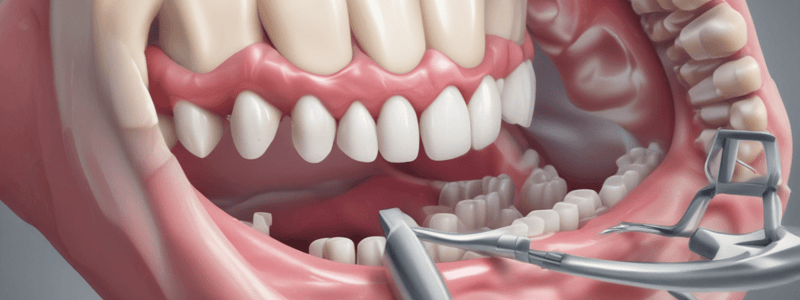Podcast
Questions and Answers
What is the purpose of using a Pressure Indicating Paste (P.I.P.) during RPD delivery?
What is the purpose of using a Pressure Indicating Paste (P.I.P.) during RPD delivery?
- To condition the teeth and ridges
- To bond the denture base to the supporting tissues
- To adjust the occlusion of the RPD to the opposing arch
- To identify areas of heavy pressure and relieve them (correct)
What is the second connotation of the term 'adjustment' in RPD delivery and adjustments?
What is the second connotation of the term 'adjustment' in RPD delivery and adjustments?
- Space maintenance in the oral cavity
- Adjustment of the denture bearing areas and occlusal surface
- Accommodation by the patient to the new prosthesis (correct)
- Maintenance and care of the RPD
What is the purpose of final adjustments in RPD delivery?
What is the purpose of final adjustments in RPD delivery?
- To condition the teeth and ridges
- To adjust the occlusion of the RPD to the opposing arch
- To adjust the denture base to the supporting tissues
- To make final adjustments to the denture base and occlusal surface (correct)
What is the purpose of patient education in RPD delivery?
What is the purpose of patient education in RPD delivery?
What is the first step in adjusting the denture base to the supporting tissues?
What is the first step in adjusting the denture base to the supporting tissues?
What is the purpose of reliving areas that displace the thin film of indicator paste?
What is the purpose of reliving areas that displace the thin film of indicator paste?
What is the primary reason for relining a distal extension base?
What is the primary reason for relining a distal extension base?
What is the difference between relining and rebasing a removable partial denture?
What is the difference between relining and rebasing a removable partial denture?
Why does a tooth-supported RPD require less frequent relining than a distal extension RPD?
Why does a tooth-supported RPD require less frequent relining than a distal extension RPD?
What is a common reason for relining or rebasing a tooth-supported RPD?
What is a common reason for relining or rebasing a tooth-supported RPD?
What should the patient be advised prior to placement of the RPD?
What should the patient be advised prior to placement of the RPD?
What is the limitation of metal framework in RPD treatment?
What is the limitation of metal framework in RPD treatment?
What is the primary purpose of using Pressure Indicating Paste?
What is the primary purpose of using Pressure Indicating Paste?
What is the significance of the retromolar pad in relation to the Removable Partial Denture?
What is the significance of the retromolar pad in relation to the Removable Partial Denture?
What is the primary goal of occlusal adjustments in the removable partial denture?
What is the primary goal of occlusal adjustments in the removable partial denture?
What is the purpose of the wax try-in in the fabrication of the removable partial denture?
What is the purpose of the wax try-in in the fabrication of the removable partial denture?
What is one of the key responsibilities of the patient in maintaining the Removable Partial Denture?
What is one of the key responsibilities of the patient in maintaining the Removable Partial Denture?
What is the purpose of protecting the remaining teeth from caries in the maintenance of the Removable Partial Denture?
What is the purpose of protecting the remaining teeth from caries in the maintenance of the Removable Partial Denture?
Flashcards are hidden until you start studying
Study Notes
RPD Delivery and Adjustments
- The term "adjustment" has two connotations: adjustment of denture bearing areas and occlusal surface, and patient accommodation to the new prosthesis.
Adjustment of Denture Bearing Areas and Occlusal Surfaces
- Adjustment involves adjusting the denture base to the supporting tissues and the occlusion of the RPD to the opposing arch.
- Final adjustments include adjustment of the denture base to the supporting tissues and adjustment of the occlusion of the RPD to the opposing arch.
Adjustment of the Denture Base to the Supporting Tissues
- A pressure indicating paste (PIP) is used to identify areas that need relief.
- The PIP is lightly painted on the denture base and the RPD is pressed onto the tissue surface with finger pressure.
- Areas that displace the paste are relieved, and the process is repeated until no areas displace the paste.
Relining and Rebasing a Removable Partial Denture
- Rebase: replacing the entire denture base material.
- Reline: resurfacing the tissue side of the removable prosthesis with new base material.
- Metal framework cannot be rebased or relined, only the acrylic denture base.
Relining
- Relining is more common than rebasing in dental practices.
- A distal extension RPD requires relining more often than a tooth-supported RPD.
- Reasons for relining a tooth-supported RPD include unhygienic conditions, unsightly conditions, and the trapping of debris between the denture base and residual ridge.
- Relief is accomplished using a slow speed handpiece, a straight nose cone, and an acrylic bur.
Pressure Indicating Paste (PIP)
- Areas frequently displaced by PIP include:
- Mandibular: lingual slope of the mandibular ridge, mylohyoid ridge, retromolar pad, and distobuccal border.
- Maxillary: inside of the buccal flange, border of the denture, and the point of the pterygomaxillary notch.
Occlusal Adjustments
- The framework of the removable partial denture should have been tried in to establish the occlusal relationships of the RPD to the opposing dentition.
- Articulating paper may be used to identify areas that need adjustment.
Follow-up Services
- Patients must understand the need for follow-up services to maintain the RPD.
- To gain maximum service from the RPD, patients must avoid careless handling, protect remaining teeth, prevent periodontal damage, and maintain healthy tissue.
Studying That Suits You
Use AI to generate personalized quizzes and flashcards to suit your learning preferences.




